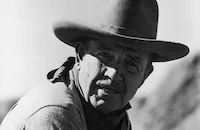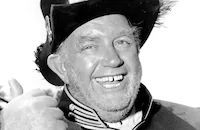The Big Game

Brief Synopsis
Cast & Crew
George Nicholls Jr.
Philip Huston
James Gleason
June Travis
Bruce Cabot
Andy Devine
Film Details
Technical Specs

Synopsis
When Atlantic University's star quarterback, Clark Jenkins, becomes romantically involved with Margaret Anthony, a coed whose father, Brad Anthony, writes a newspaper sports column, he takes criticism for accepting money from gambler George Scott. Clark explains that without George's subsidies, he and other players like Pop, a former coal miner and father of three, would be unable to afford college. After news of an injury to Clark's knee is leaked to George and his gambling network by Clark's roommate, Cal Calhoun, the betting suddenly switches to favor Atlantic's next opponent. This switch alerts Anthony, who later sees Clark talking to gambling kingpin Blackie Dawson at a practice session. Convinced that Clark has been feeding information to Dawson, Anthony writes a damning column about him and reports him to the university's board of directors. Fuelled by the coach's speech about the financial importance of football to the university, the board, however, declares Clark innocent. Although cleared, Clark storms at Cal and accuses him of being a selfish, cowardly player who would rather run with the ball than block for his teammates. On the morning before Atlantic's big game with Erie, Clark receives a telephone call about his brother Pete, a professional boxer, and is told to go to a particular hotel room to help him, unaware that Dawson plans to kidnap him in order to guarantee Atlantic's loss. Eventually Pete, Margaret and several of Clark's teammates track down and beat up the gangsters, and while a reformed Cal is blocking for victory and Pop is stalling the game by provoking an on-field riot, a liberated Clark is rushed to the stadium in time to win the big game and marry Margaret.

Director
George Nicholls Jr.
Cast

Philip Huston

James Gleason

June Travis

Bruce Cabot

Andy Devine

Guinn Williams

John Arledge

C. Henry Gordon
Jay Berwanger
William Shakespeare
Robert [bobby] Wilson
James [monk] Moscrip
Irwin [king Kong] Klein
Gomer Jones
Robert [bones] Hamilton
Frank Alustiza
Chuck Bennis
Frank M. Thomas

Barbara Pepper

Edward Nugent
Margaret Seddon

Billy Gilbert
John Harrington
Murray Kinnell
Crew

Film Details
Technical Specs

Articles
The Big Game
By Richard Harland Smith

The Big Game
Quotes
Trivia
Francis Wallace's novel "Big Game" was first published as a serial entitled "Odds Against Honor" in Collier's magazine in 1935. The idea for the riot scene came from an actual riot at a New York University-Fordham University football game. RKO bought 1000 feet of the 1935 Rose Bowl game footage for use in the film.
Notes
Francis Wallace's novel was first published as a serial in Collier's under the title Odds Against Honor (26 October 1935-14 December 1935). Wallace was a former sports writer for the New York Daily News. According to onscreen credits, player Jay Berwanger attended the University of Chicago; William Shakespeare, Notre Dame; Robert Wilson, Southern Methodist; Irwin Klein, New York University; Gomer Jones, Ohio State; Chuck Bennis, University of Illinois, and James Moscrip, Robert Hamilton and Frank Alustiza, Stanford University. For this production, RKO borrowed Andy Devine from Universal, June Travis from Warner Bros., and Bruce Cabot from M-G-M. Novelist Irwin Shaw, who had just won acclaim on Broadway for his one-act play "Bury the Dead," made his screenwriting debut with the picture. According to Motion Picture Herald's "In the Cutting Room," scenes for the film were shot at several Southern California university campuses and at the Rose Bowl in Pasadena. A Hollywood Reporter news item announced that RKO had purchased from independent producer Sam Katzman 1,000 feet of film taken at the 1935 Rose Bowl game. Motion Picture Herald's "In the Cutting Room" adds Red Cagle as a cast member, but his participation in the final film has not been confirmed. According to Variety, the idea for the riot scene in the picture came from an actual on-the-field melee that took place at a New York University-Fordham University football game.















